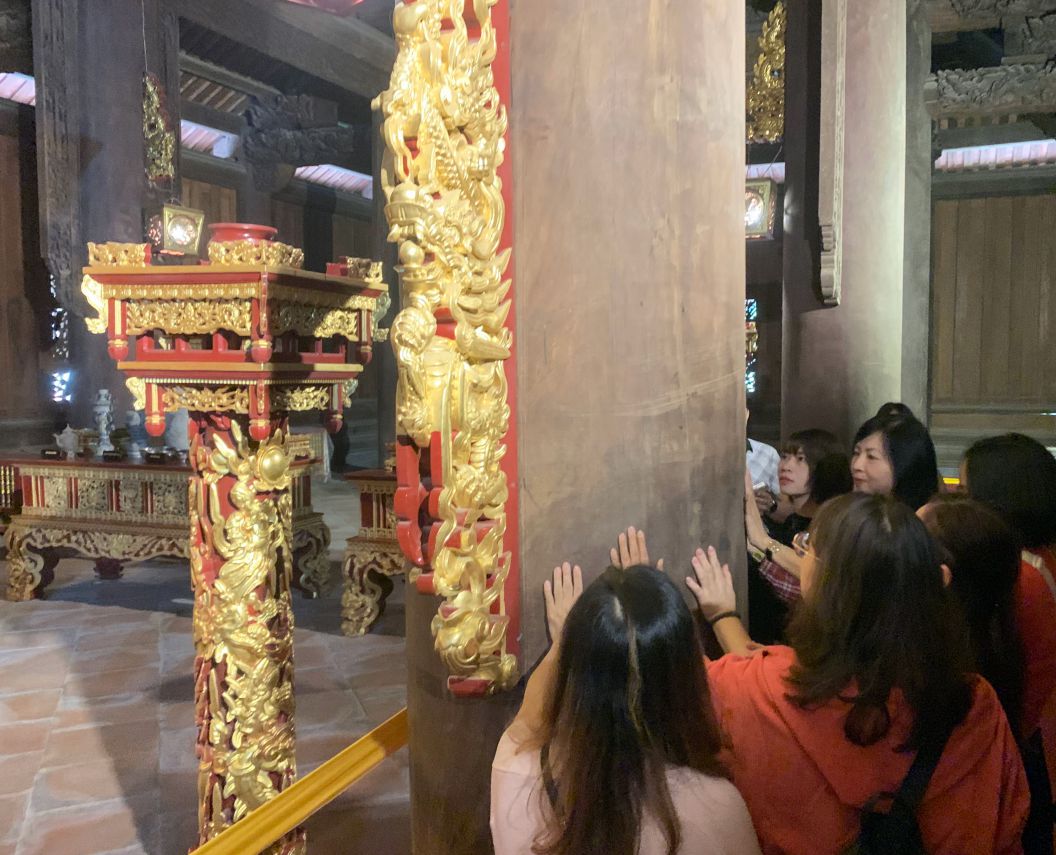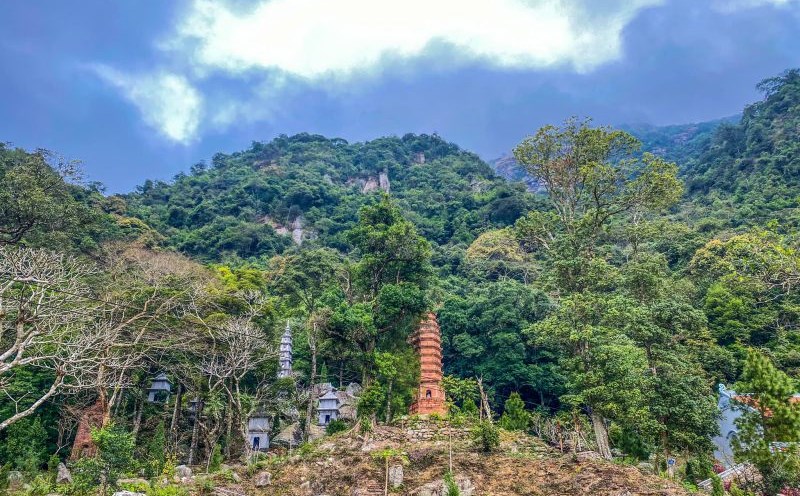The banyan tree embraces the star apple tree.
Entering the corner of the Dragon Courtyard in Lam Kinh relic, visitors will see a majestic heritage tree next to Ngo Mon gate. It is a banyan tree over 300 years old. The tree is about 40m high, the trunk is so big that 10 people can hug it, the giant roots are spread out all around.
A representative of the Lam Kinh National Historical Site Management Board said that Ngo Mon Gate used to have two brick walls. After these two walls collapsed, a fig tree grew up to the right of Ngo Mon Gate. In the summer, the fig tree bears fragrant fruit, and birds come to eat it.
According to oral tradition, it is unknown when the flock of birds came to eat the star fruit and also took away the banyan seeds. The banyan seeds fell to the ground, germinated and grew around the star fruit tree. Since then, the Ngo Mon Gate has a tree with two tops, one banyan and one star fruit. In winter, the banyan tree bears fruit, in summer the star fruit tree bears fruit. The people in the area call this tree the banyan tree.
By 2007, the fig tree was gradually withering away amidst the tangled roots. The tree died completely, leaving only the banyan tree. But about 15 years later, a small fig tree grew right from the base of the banyan tree. Today, the small fig tree is about 2m tall.
Some people believe that this is a remaining branch from the old fig tree, while others believe that the fig tree has "reincarnated" to be a companion to the old banyan tree.
In 2013, the Vietnam Association for Conservation of Nature and Environment recognized this banyan tree as a Vietnam Heritage Tree.

Sacrificial ironwood tree
When visiting the Lam Kinh historical site, visitors will have the opportunity to listen to the process of restoration, renovation and embellishment of ancient architectural works. The most elaborate is probably the restoration of the Main Hall from 2010 to 2022. The Hall is located in the middle of the largest central area in the shape of the letter "cong", including 3 buildings called Quang Duc, Sung Hieu, Dien Khanh. The Main Hall is about 1,650m2 wide with 138 foundations, of which 124 foundations remain, and is currently being reconstructed on the old foundation.
According to the Lam Kinh Relic Management Board, in 2010, when the Lam Kinh Main Hall restoration project was approved, a 600-year-old lim tree in the lush green campus suddenly shed all its leaves. By the time the design and construction of the Main Hall was completed, the lim tree had dried up. After the incident was reported to the Thanh Hoa Provincial People's Committee, the authorities decided to hold a "wood cutting" ceremony to cut down the tree to reconstruct the main hall. In 2011, on the anniversary of King Le Thai To's death, Thanh Hoa Province held a tree cutting ceremony.
“There are many strange coincidences. From the time the lim tree sheds its leaves until the tree-cutting ceremony, it takes about 6-7 months, but when the tree-cutting ceremony is held, a stream of red sap like blood still oozes from the trunk. The lim tree is 600 years old but it is not hollow from root to top,” said a tour guide of the Lam Kinh Relic Site.
The lim tree trunk is about 80 - 82cm in diameter, fitting perfectly into the main stone base - the base of the wooden pillar in the back hall of the Main Hall. The tree trunk is about 7m high and begins to divide into 2 branches. When lowered, one branch is about 65cm in diameter, fitting perfectly into the base of the stone base on the wall of the main hall, one branch is 45cm in diameter, fitting perfectly into the base of the porch on the sidewalk outside the Main Hall and some of the remaining parts are used as upper beams.
What is special is that the lim tree lives in the forest where Le Loi established the Lung Nhai Oath. The lim tree and many other trees in the forest provided shelter for the Lam Son insurgents from the enemy. This lim tree is a "divine tree", receiving the spiritual energy of heaven and earth for hundreds of years. Many people believe that the ancient lim tree was born in the sacred land of Lam Kinh with the noble mission of 600 years later, which is to restore the main hall, showing the majestic spirit of the capital of the early Le dynasty.
Guava tree "laughs"
Behind Lam Kinh Main Hall is the tomb of King Le Thai To. The resting place of King Le Thai To is located amidst lush green forest canopy. Centuries-old trees such as the 600-year-old sui tree and the over 300-year-old glutinous oak tree in the mausoleum grounds are all honored as heritage trees.
Most special is a nearly 100-year-old guava tree located on the right side of the entrance to the king's tomb. The ancient guava tree is about 3m tall, shaped like a dragon, with branches spreading in four directions, and bears fruit all year round. The fruit is only about the size of a thumb, but it is fragrant and sweet when ripe. The mausoleum's caretaker picks the fruit every guava season to offer to the king's tomb.
It was not until the year 2000 that people discovered that this guava tree could “smile”. Whenever someone scratched the tree’s hollow, trunk or base, the branches and leaves would immediately shake as if the tree was smiling. The tree would stand still again as soon as no one touched the trunk or base. However, the guava seedlings that were grafted and planted in other areas did not have the “smiling” gene like the mother tree.
Another thing that is more difficult to explain is that if visitors try to hold the tree trunk and close their eyes, and meditate for a moment, they will feel as if they are flying, their mind spinning.
The tour guide of the relic said that the "laughing" guava tree was originally donated by Mr. Tran Hung Dan (Hanh Thien village, Xuan Hong commune, Xuan Truong district, Nam Dinh) in 1933. Mr. Dan also donated 4 elephant statues, 2 camphor trees and a guava tree to plant in the king's tomb.
In 2003, Associate Professor Dr. Ha Dinh Duc visited Lam Kinh relic and studied the phenomenon of the “smiling” guava tree with his companions. They discovered that every time someone scratched or gently rubbed the guava tree, the tree bark warmed up, and an electric current appeared in the trunk and transmitted to the branches and leaves.
In 2008, the Ministry of Science and Technology also had a national research project on the genes of guava trees in Lam Kinh but there were no results yet.
Located about 50km from the center of Thanh Hoa city, Lam Kinh National Special Relic Site is located in the land of Lam Son, Tho Xuan district, Thanh Hoa province. Lam Kinh is the homeland of the Le dynasty - the sacred land that gave birth to national hero Le Loi, the birthplace of the famous Lam Son uprising in the 15th century, gathering heroes to rise up to fight the enemy and defend the country. "Complete Annals of Dai Viet" recorded that in 1430, after ascending the throne, Emperor Le Thai To changed Lam Son land to Lam Kinh or Tay Kinh to distinguish it from Dong Kinh - Hanoi. Lam Kinh became the basic land of Dai Viet during the Le dynasty. In 1433, after King Le Thai To passed away and was brought back to Lam Kinh for burial, temples and shrines began to be built. The book "Dai Viet Su Ky Toan Thu" clearly states: Lam Kinh was built in 1433, the king sent the Right Minister Le Nhu Lam to Lam Kinh to build the temple of Thai Mau, in the same year Lam Kinh temple burned down. In 1448, King Le Nhan Tong issued an edict to Thai Uy Le Kha and the Department of Bach Tac to rebuild Lam Kinh temple. Lam Kinh continued to be built, and was completed in February 1449. In 1962, Lam Kinh historical relic was ranked at the national level, and in 1994, the Government approved the restoration project. Up to now, many construction items of the relic site have been restored, avoiding desolation, and protecting many ancient relics of the Le dynasty.











